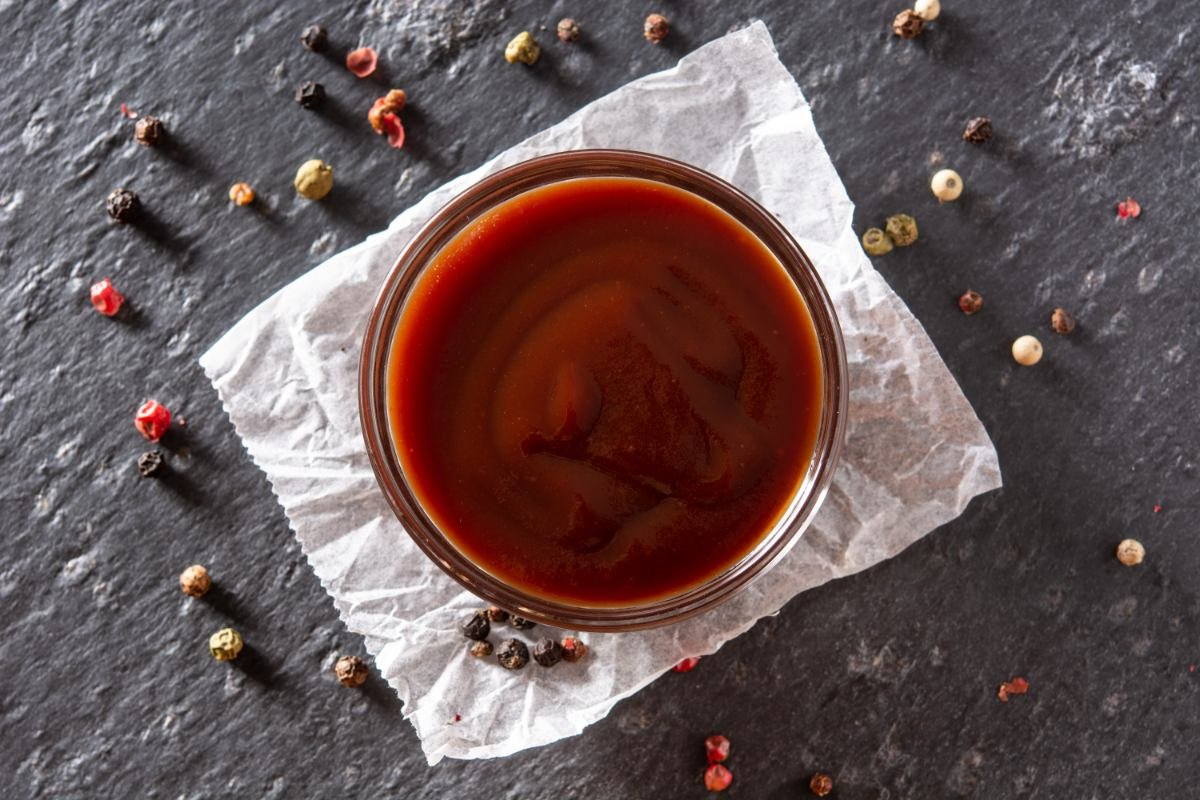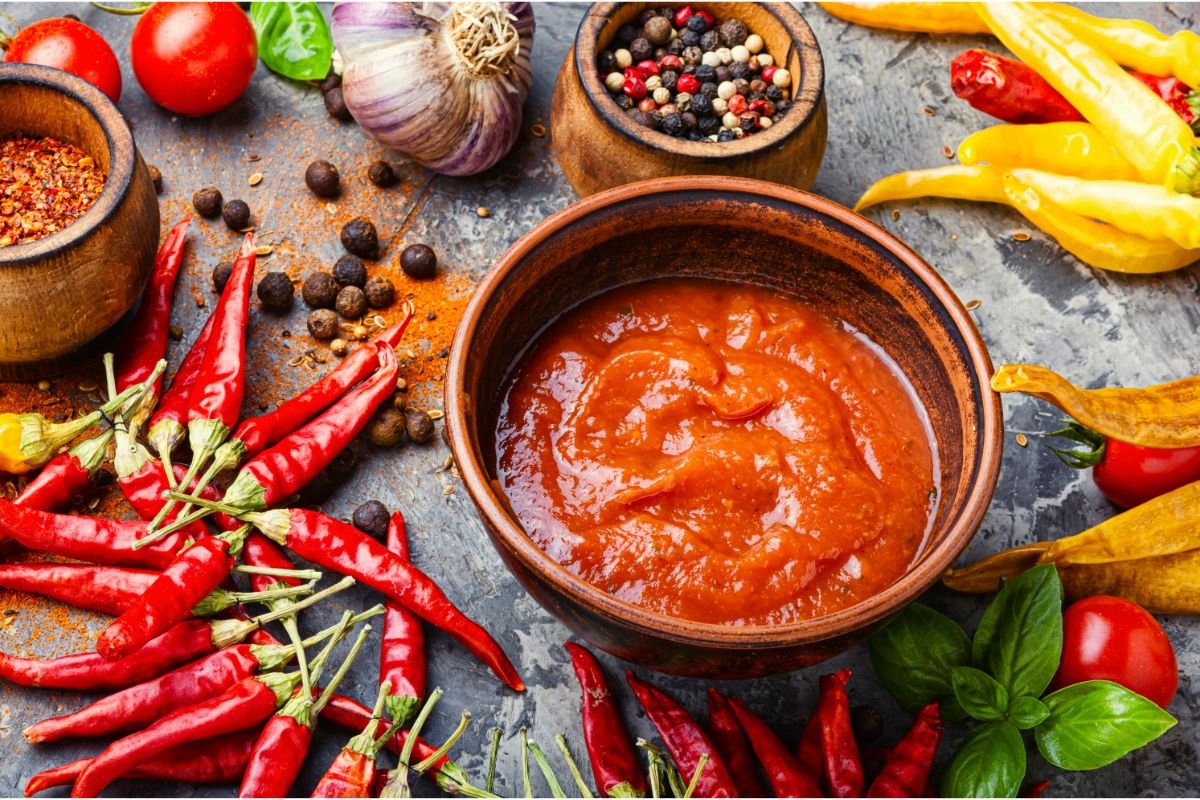Introduction to Togarashi Sauce
Togarashi sauce, a vibrant condiment rooted in Japanese cuisine, has transcended its traditional boundaries to become a beloved ingredient worldwide. Known for its complex flavor profile that seamlessly blends heat, umami, and a hint of citrus, togarashi sauce is much more than just a seasoning—it’s a culinary bridge between the past and the present.
Originating from the blend of spices known as Shichimi Togarashi, which dates back to the 17th century, the sauce variation incorporates these spices into a liquid form, making it a versatile and indispensable kitchen staple. What makes togarashi sauce truly unique is its ability to enhance the flavors of a dish without overpowering it, a testament to the subtlety and depth of Japanese culinary philosophy.
The Ingredients of Togarashi Sauce

The magic of togarashi sauce lies in its ingredients, a blend that can vary but typically includes:
- Chili Peppers: The heat element, providing a spicy kick.
- Sansho Pepper or Sichuan Peppercorns: Adds a numbing effect and a citrus-like aroma.
- Seaweed: Introduces umami and a hint of the ocean.
- Sesame Seeds: Offers a nutty flavor and texture contrast.
- Dried Orange Peel: Brings a subtle citrus note.
- Ginger: Adds a spicy, warm dimension.
- Poppy Seeds: Contribute to the sauce’s complexity with their nutty and slightly sweet taste.
This blend, combined with a base of soy sauce, vinegar, or another liquid, creates a sauce that is rich in flavors and textures. Regional differences in Japan and personal preferences can lead to variations in the recipe, with some adding ingredients like garlic, yuzu juice, or honey for added depth and complexity.
Culinary Uses of Togarashi Sauce
Togarashi sauce, with its versatile flavor profile, finds its place in numerous dishes, enriching them with its unique blend of heat, umami, and a subtle zest. From traditional Japanese cuisine to avant-garde culinary creations, this sauce adds depth and complexity to every meal it graces.
Elevating Traditional Japanese Dishes
Togarashi sauce breathes new life into classic Japanese recipes, offering a modern twist on age-old flavors. It serves as a dynamic complement to sushi and sashimi, enhancing the fresh flavors of the fish with its spicy and citrusy notes. Ramen and udon bowls also benefit from a dash of togarashi sauce, where it infuses the broth with an additional layer of warmth and complexity. Not to be overlooked, grilled meats and vegetables take on a new dimension when brushed with togarashi sauce, highlighting the grill’s smoky flavors with its spicy-sweet undertones.
Modern Culinary Innovations
Chefs around the world are embracing togarashi sauce, incorporating it into a wide array of dishes that transcend traditional Japanese cuisine. Fusion tacos, for instance, receive a burst of flavor with togarashi sauce drizzled over the top, marrying the heat of the sauce with the freshness of the fillings. In vegetarian and vegan dishes, togarashi sauce offers a much-needed umami boost, making plant-based meals more satisfying and flavorful. Even desserts are not immune to its charm; a light sprinkle of togarashi sauce can transform vanilla ice cream into an exotic treat, proving that this versatile sauce knows no boundaries.
Pairings with Other Foods
The art of pairing togarashi sauce with other foods is a testament to its versatility. Seafood, with its delicate flavors, is perfectly complemented by the sauce’s depth, enhancing dishes without overwhelming them. Togarashi sauce also finds a harmonious match in creamy dishes, such as risottos or pasta with white sauces, where it cuts through the richness with its spicy and acidic notes. For those who enjoy bold flavors, pairing togarashi sauce with cheeses, especially soft and creamy varieties, creates an exquisite balance of heat and texture.
Health Benefits and Nutritional Value of Togarashi Sauce
Togarashi sauce, a symphony of spices and flavors, offers more than just taste enhancement. Its components carry a plethora of health benefits, making this condiment a valuable addition to a balanced diet.
Nutritional Breakdown
At its core, togarashi sauce combines ingredients rich in vitamins, minerals, and antioxidants. The chili peppers, a key ingredient, are high in vitamin C and capsaicin, the latter known for its metabolism-boosting properties. Sansho pepper, another spice in the mix, is celebrated for its anti-inflammatory effects, thanks to its high content of antioxidants. The sesame seeds sprinkled into the sauce contribute calcium and magnesium, essential for bone health, while seaweed rounds off the mixture with iodine, crucial for thyroid function. This unique blend of ingredients makes togarashi sauce not only a flavor booster but also a nutrient powerhouse.
Potential Health Benefits
Integrating togarashi sauce into your diet offers several health advantages. The capsaicin from chili peppers not only spices up your meals but also aids in weight management by increasing metabolism and fat burning. Moreover, the anti-inflammatory properties of sansho pepper can help alleviate pain and reduce the risk of chronic diseases. The antioxidants present in the sauce, particularly from ginger and dried orange peel, support immune function and protect against oxidative stress, potentially warding off various illnesses.
Considerations and Dietary Restrictions
While togarashi sauce is a beneficial addition to many diets, it’s important to consume it in moderation, especially for those with certain dietary restrictions or sensitivities. The sauce’s spicy nature might not be suitable for individuals with digestive issues, such as acid reflux or irritable bowel syndrome. Additionally, those with allergies to sesame seeds or other specific ingredients should exercise caution. As always, it’s best to consult with a healthcare provider to ensure that togarashi sauce is a good fit for your dietary needs.
Making Togarashi Sauce at Home
Creating togarashi sauce from scratch allows for a delightful exploration of flavors and textures. With a few key ingredients and simple steps, you can produce a sauce that rivals any store-bought version in both taste and freshness.
Basic Recipe and Instructions
To start, you’ll need the following ingredients:
- Chili peppers (dried or fresh, depending on your heat preference)
- Sansho pepper or Sichuan peppercorns
- Seaweed (nori is a common choice)
- Sesame seeds
- Dried orange peel
- Ginger (fresh or dried)
- Soy sauce or a mix of soy sauce and vinegar for the base
- Grind the dry ingredients: Using a spice grinder or mortar and pestle, finely grind the chili peppers, sansho pepper, seaweed, sesame seeds, dried orange peel, and ginger.
- Combine with the liquid base: Mix the ground spices with soy sauce (and vinegar, if using) in a bowl. The quantity of soy sauce can be adjusted based on the desired consistency.
- Adjust and taste: Experiment with the balance of flavors, adding more of any ingredient according to your taste preferences.
- Let it meld: Allow the sauce to sit for a few hours or overnight, letting the flavors fully develop.
Tips for Customization
Making togarashi sauce at home presents an opportunity to tailor it to your personal taste. Consider adding a touch of honey for sweetness, yuzu juice for a citrusy zing, or garlic for a deeper flavor profile. The key to a great togarashi sauce is finding the right balance of flavors that appeal to you. Don’t hesitate to experiment with different proportions and additional ingredients to create a sauce that perfectly complements your dishes.
Preservation and Storage
To ensure your togarashi sauce retains its flavor and freshness, proper storage is crucial. Store the sauce in an airtight container in the refrigerator, where it can keep for several weeks. For longer preservation, consider freezing the sauce in an ice cube tray, allowing you to use small portions as needed without having to thaw the entire batch. This method not only extends the sauce’s shelf life but also offers convenience for future cooking endeavors.
The Cultural Significance of Togarashi Sauce
Togarashi sauce has deep roots in Japanese culinary traditions. Its story is one of evolution and adaptability. Here, we explore its impact and presence in both historical and modern contexts.
Historical Context and Cultural Importance
Togarashi sauce began with Shichimi Togarashi in the 17th century. Initially, it enhanced soups, noodles, and meats. Over time, it transformed into a versatile sauce. This shift reflects Japanese cuisine’s adaptability. Togarashi sauce serves as a link between past flavors and today’s culinary creativity. It honors tradition while welcoming new practices.
Togarashi in Contemporary Cuisine and Media
Recently, togarashi sauce has gained global fame. It appears in cooking shows, competitions, and blogs. This attention showcases its versatility and introduces Japanese culinary traditions to a wider audience. As a result, togarashi sauce has become a symbol of cultural exchange. It highlights a shared love for exploring new flavors.
Conclusion
In essence, togarashi sauce celebrates the joy of cooking and eating, embodying the rich traditions and inviting new culinary experiences. It stands as a testament to the power of food in bringing people together across cultures. For those looking to dive deeper into the fascinating world of Japanese cuisine and its spices, the Gourmet Society’s comprehensive guide offers a wealth of knowledge and insights.
Visit RecipesZap to embark on your culinary journey with togarashi sauce. Here’s to creating vibrant dishes that honor tradition and spark innovation in your kitchen.

